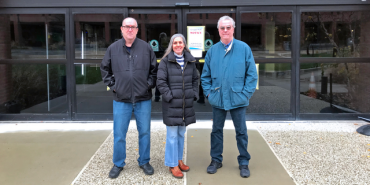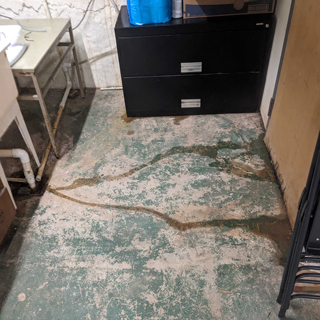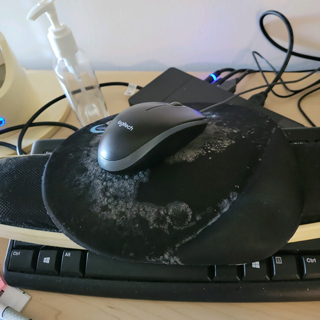The flooded basement of “Lang and Lit,” the language and literature department in Grupp Hall at Bucks County Community College, had become a running joke: One professor called the steady flow of water from a leaky roof the campus’ only “lazy river.” Ceiling tiles were crumbling with moisture, and mold bloomed on walls and furniture.
Today it’s no laughing matter. At least two campus buildings have tested positive for lead in the water, black mold, radon and other toxins. Six women who worked inn Founders Hall have been diagnosed with breast cancer, one of the cancers some studies link to exposure to environmental toxins. Other grave illnesses among faculty and staff are a continuing concern.
“I looked around at my colleagues in my department and there are six of us who have this,” says Kathi Knight, an environmental scientist who was diagnosed with breast cancer after working in Founders Hall. “Then I started looking at prostate cancer. Then the sarcomas. Then I started to really notice the people who have respiratory issues, who have leaking offices.”
Knight, who is the first vice president of the Bucks County Community College Federation of Teachers, describes one colleague in his 40s who takes steroids to control coughing fits that leave him breathless; there is “black mold everywhere under his ceiling tile,” she says. Another went on sabbatical and didn’t need an inhaler until she returned to the building, says local President John Sheridan. And of course, no one wants the students exposed to environmental hazards in these classrooms.
The union complained to the administration about building conditions 10 years ago, but administrators didn’t want to test. So the union had the buildings tested, but then administrators didn’t trust their data. The second time the union complained, when Grupp Hall flooded and faculty had to remove all their belongings for cleanup, administrators replaced soggy ceiling tiles and walls with new drywall, and the underlying problems remained. “They just put a Band-Aid on it,” says Sheridan.
This time, the union has combined academic expertise, union acumen, community connections and sheer persistence to push for a more robust response from the college, and they’ve gotten it.
“It’s something that we can’t overlook,” says Sheridan. “It has to be taken care of.”
Testing, testing
Earlier this year the union convinced administrators to address their concerns in a more serious way, beginning with environmental testing. The college hired an environmental testing firm that produced a 466-page report on conditions in two buildings that appear to be most problematic—Grupp Hall, which the language and literature department shares with communications, business and social sciences; and Founders Hall, with science, technology, engineering, mathematics, nursing and more communications.
Six building samples showed lead in the water at levels above the “action level” defined by the Environmental Protection Agency. Two samples showed high levels of Legionella, the bacterium that causes Legionnaires’ disease. High levels of radon appeared in seven offices, some at levels more than double what is acceptable. High levels of mold were found in numerous locations.
Recommendations for remediation were minor in some cases, and vague in others: For lead, run the water for 15 to 30 seconds before using. For Legionella, recirculate water, flush the system regularly and consult Legionella experts. For mold, professionally clean surfaces with fungicide; clean heating, ventilation and air conditioning units; and replace contaminated ceiling tiles. But no recommendation mentioned addressing the roof leaks causing the moisture to enter in the first place. And while the report recommended that the college “reduce radon levels,” it gave no specific suggestions about how to do that.
More troubling were the discrepancies Knight found as she pored over the report. The summary showed no PFAS—an abbreviation for perfluoroalkyl and polyfluoroalkyl substances, a group of chemicals—that violated standards, but the raw data in its appendix showed PFAS at levels exceeding those recommended by the EPA. “These PFAS compounds are referred to as forever compounds as they do not break down, they bioaccumulate in the body, and have many harmful health effects,” says Knight. She also saw no tests for phthalates and other carcinogens associated with the kinds of cancers that were turning up.
The union also says plans for remediation were insufficient: Grupp Hall was treated for mold twice in the past, but the mold returned, indicating that treatment was ineffective or the root cause was not addressed. And plans to alleviate radon problems with vents in office doors—a suggestion made early in the project—do not address the insidious nature of radon, which continues to enter buildings through basement wall cracks unless these are located and sealed.
Making demands
With a thorough review of the report in hand, the union was ready to make demands that the toxic building issues be addressed in a more robust manner. This time their demands were taken seriously.
What was the difference? For one thing, new contract language crafted during the pandemic more clearly protects the health and safety of campus workers. The union never filed a grievance—but with longtime grievance officer Michael Hennessey, whose deep institutional knowledge has informed the four contracts he’s helped bargain, it was more than ready. Administrators realized, says Hennessey, that the union was “not going to stand down on this. We’re going to take a stand for our people.”
The union has also built strong connections to the community, working with local elected officials on policies important to workers and to higher education. Another strength was the Building Related Illnesses Ad Hoc Committee created by labor and management together. It ticks all the boxes: Along with Knight’s scientific expertise, union member Mary Dura, a professor of nursing and a registered nurse, uses her professional experience to connect the dots between high levels of toxins and the health risks they present. Hennessey and Sheridan bring union leadership and savvy. And, crucially, Provost Kelly Kelleway agreed to join the committee and has demonstrated a real commitment to addressing health and safety in the buildings—fueled in part by her experience as a former literature professor and dean in Grupp Hall.
Another important step toward successful action has been support from the college board of trustees. After struggling with what he calls a lack of transparency from the now-outgoing college president, Sheridan went directly to the board when Knight’s findings were dismissed. They immediately agreed that health and safety were paramount.
Real results
As a result of the committee’s work—and the union’s persistence—the college is moving ahead with remediation plans. The contaminated wells have been abandoned and the college now uses township water. The bottom two floors of Grupp Hall have been evacuated for aggressive remediation over winter break. Plans are in place to remove contaminated carpeting and sanitize buildings, including HVAC systems.
The college has also hired an environmental and occupational sick building consultant, issued a request for proposals for mold and bacterial remediation, posted signs on sinks that water should run for 30 seconds prior to use to clear lead and other contaminants (a Centers for Disease Control and Prevention-approved remediation measure), and posted an “out of order” sign on the water fountain that had higher-than-recommended levels of lead. On a grander scale, rooftop issues will be evaluated to get at the origin of leaks, moisture and mold.
One of the primary obstacles to remediation will be cost, says Sheridan. Roof replacement would run into the millions of dollars. So the union has initiated a subcommittee to explore possible funding resources and is meeting with state legislators and county commissioners to consider options. Sheridan and Hennessey meet weekly with the provost to make sure the project continues to move forward.
“We have to keep hammering away at it,” says Sheridan, who adds that the committee members are highly motivated. “I’m really invested in our people and the federation,” confirms Hennessey, who notes the progress the union has made in working more collaboratively with administrators. “I want to leave this place a better place than I found it.”
[Virginia Myers]



